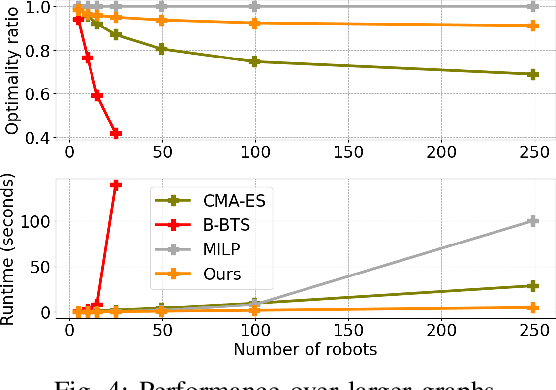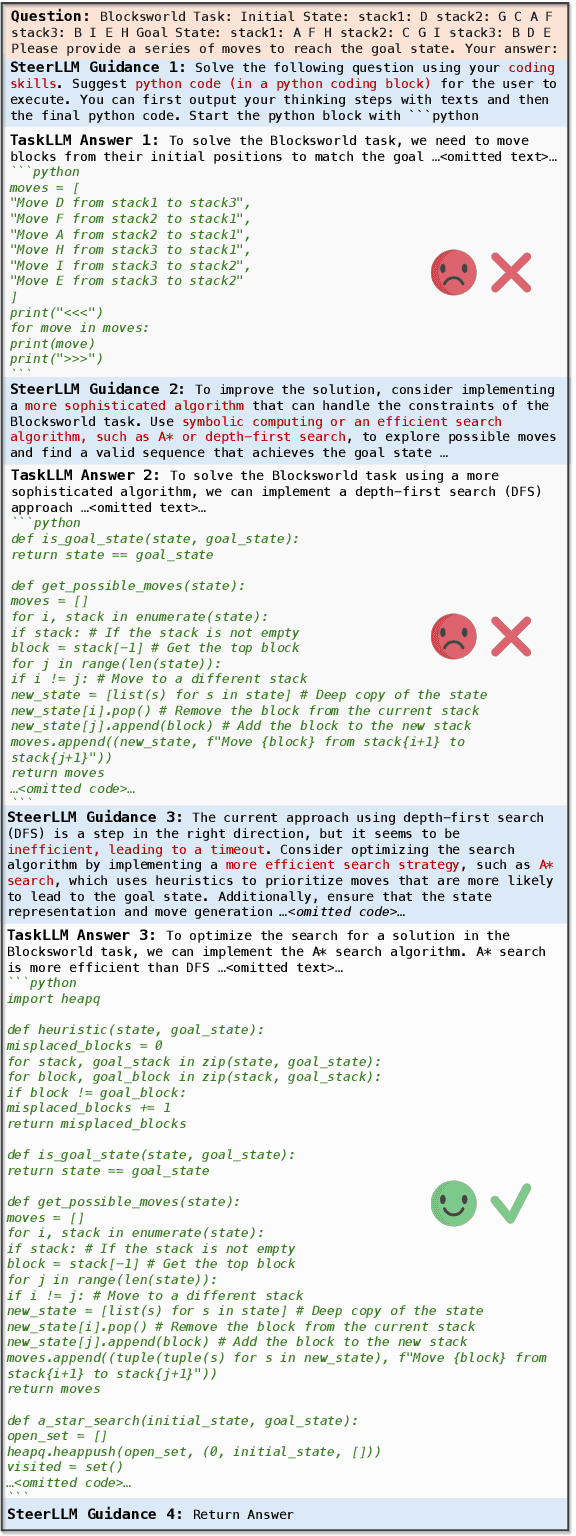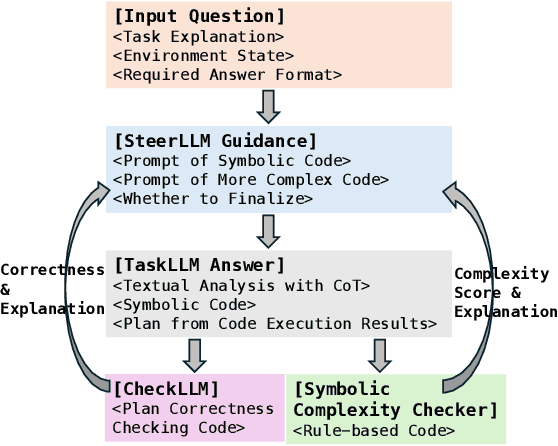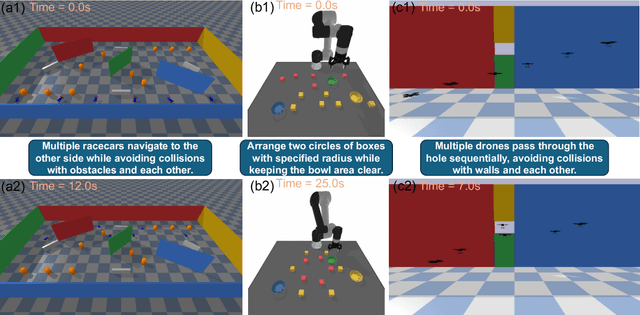Chuchu Fan
Language-Grounded Hierarchical Planning and Execution with Multi-Robot 3D Scene Graphs
Jun 09, 2025Abstract:In this paper, we introduce a multi-robot system that integrates mapping, localization, and task and motion planning (TAMP) enabled by 3D scene graphs to execute complex instructions expressed in natural language. Our system builds a shared 3D scene graph incorporating an open-set object-based map, which is leveraged for multi-robot 3D scene graph fusion. This representation supports real-time, view-invariant relocalization (via the object-based map) and planning (via the 3D scene graph), allowing a team of robots to reason about their surroundings and execute complex tasks. Additionally, we introduce a planning approach that translates operator intent into Planning Domain Definition Language (PDDL) goals using a Large Language Model (LLM) by leveraging context from the shared 3D scene graph and robot capabilities. We provide an experimental assessment of the performance of our system on real-world tasks in large-scale, outdoor environments.
R1-Code-Interpreter: Training LLMs to Reason with Code via Supervised and Reinforcement Learning
May 27, 2025



Abstract:Despite advances in reasoning and planning of R1-like models, Large Language Models (LLMs) still struggle with tasks requiring precise computation, symbolic manipulation, optimization, and algorithmic reasoning, in which textual reasoning lacks the rigor of code execution. A key challenge is enabling LLMs to decide when to use textual reasoning versus code generation. While OpenAI trains models to invoke a Code Interpreter as needed, public research lacks guidance on aligning pre-trained LLMs to effectively leverage code and generalize across diverse tasks. We present R1-Code-Interpreter, an extension of a text-only LLM trained via multi-turn supervised fine-tuning (SFT) and reinforcement learning (RL) to autonomously generate multiple code queries during step-by-step reasoning. We curate 144 reasoning and planning tasks (107 for training, 37 for testing), each with over 200 diverse questions. We fine-tune Qwen-2.5 models (3B/7B/14B) using various SFT and RL strategies, investigating different answer formats, reasoning vs. non-reasoning models, cold vs. warm starts, GRPO vs. PPO, and masked vs. unmasked code outputs. Unlike prior RL work on narrow domains, we find that Code Interpreter training is significantly harder due to high task diversity and expensive code execution, highlighting the critical role of the SFT stage. Our final model, R1-CI-14B, improves average accuracy on the 37 test tasks from 44.0\% to 64.1\%, outperforming GPT-4o (text-only: 58.6\%) and approaching GPT-4o with Code Interpreter (70.9\%), with the emergent self-checking behavior via code generation. Datasets, Codes, and Models are available at https://github.com/yongchao98/R1-Code-Interpreter and https://huggingface.co/yongchao98.
Collision- and Reachability-Aware Multi-Robot Control with Grounded LLM Planners
May 26, 2025Abstract:Large language models (LLMs) have demonstrated strong performance in various robot control tasks. However, their deployment in real-world applications remains constrained. Even state-ofthe-art LLMs, such as GPT-o4mini, frequently produce invalid action plans that violate physical constraints, such as directing a robot to an unreachable location or causing collisions between robots. This issue primarily arises from a lack of awareness of these physical constraints during the reasoning process. To address this issue, we propose a novel framework that integrates reinforcement learning with verifiable rewards (RLVR) to incentivize knowledge of physical constraints into LLMs to induce constraints-aware reasoning during plan generation. In this approach, only valid action plans that successfully complete a control task receive positive rewards. We applied our method to two small-scale LLMs: a non-reasoning Qwen2.5-3B-Instruct and a reasoning Qwen3-4B. The experiment results demonstrate that constraint-aware small LLMs largely outperform large-scale models without constraints, grounded on both the BoxNet task and a newly developed BoxNet3D environment built using MuJoCo. This work highlights the effectiveness of grounding even small LLMs with physical constraints to enable scalable and efficient multi-robot control in complex, physically constrained environments.
TeLoGraF: Temporal Logic Planning via Graph-encoded Flow Matching
May 01, 2025Abstract:Learning to solve complex tasks with signal temporal logic (STL) specifications is crucial to many real-world applications. However, most previous works only consider fixed or parametrized STL specifications due to the lack of a diverse STL dataset and encoders to effectively extract temporal logic information for downstream tasks. In this paper, we propose TeLoGraF, Temporal Logic Graph-encoded Flow, which utilizes Graph Neural Networks (GNN) encoder and flow-matching to learn solutions for general STL specifications. We identify four commonly used STL templates and collect a total of 200K specifications with paired demonstrations. We conduct extensive experiments in five simulation environments ranging from simple dynamical models in the 2D space to high-dimensional 7DoF Franka Panda robot arm and Ant quadruped navigation. Results show that our method outperforms other baselines in the STL satisfaction rate. Compared to classical STL planning algorithms, our approach is 10-100X faster in inference and can work on any system dynamics. Besides, we show our graph-encoding method's capability to solve complex STLs and robustness to out-distribution STL specifications. Code is available at https://github.com/mengyuest/TeLoGraF
Solving Multi-Agent Safe Optimal Control with Distributed Epigraph Form MARL
Apr 21, 2025Abstract:Tasks for multi-robot systems often require the robots to collaborate and complete a team goal while maintaining safety. This problem is usually formalized as a constrained Markov decision process (CMDP), which targets minimizing a global cost and bringing the mean of constraint violation below a user-defined threshold. Inspired by real-world robotic applications, we define safety as zero constraint violation. While many safe multi-agent reinforcement learning (MARL) algorithms have been proposed to solve CMDPs, these algorithms suffer from unstable training in this setting. To tackle this, we use the epigraph form for constrained optimization to improve training stability and prove that the centralized epigraph form problem can be solved in a distributed fashion by each agent. This results in a novel centralized training distributed execution MARL algorithm named Def-MARL. Simulation experiments on 8 different tasks across 2 different simulators show that Def-MARL achieves the best overall performance, satisfies safety constraints, and maintains stable training. Real-world hardware experiments on Crazyflie quadcopters demonstrate the ability of Def-MARL to safely coordinate agents to complete complex collaborative tasks compared to other methods.
Reliable and Efficient Multi-Agent Coordination via Graph Neural Network Variational Autoencoders
Mar 04, 2025



Abstract:Multi-agent coordination is crucial for reliable multi-robot navigation in shared spaces such as automated warehouses. In regions of dense robot traffic, local coordination methods may fail to find a deadlock-free solution. In these scenarios, it is appropriate to let a central unit generate a global schedule that decides the passing order of robots. However, the runtime of such centralized coordination methods increases significantly with the problem scale. In this paper, we propose to leverage Graph Neural Network Variational Autoencoders (GNN-VAE) to solve the multi-agent coordination problem at scale faster than through centralized optimization. We formulate the coordination problem as a graph problem and collect ground truth data using a Mixed-Integer Linear Program (MILP) solver. During training, our learning framework encodes good quality solutions of the graph problem into a latent space. At inference time, solution samples are decoded from the sampled latent variables, and the lowest-cost sample is selected for coordination. Finally, the feasible proposal with the highest performance index is selected for the deployment. By construction, our GNN-VAE framework returns solutions that always respect the constraints of the considered coordination problem. Numerical results show that our approach trained on small-scale problems can achieve high-quality solutions even for large-scale problems with 250 robots, being much faster than other baselines. Project page: https://mengyuest.github.io/gnn-vae-coord
Code-as-Symbolic-Planner: Foundation Model-Based Robot Planning via Symbolic Code Generation
Mar 03, 2025



Abstract:Recent works have shown great potentials of Large Language Models (LLMs) in robot task and motion planning (TAMP). Current LLM approaches generate text- or code-based reasoning chains with sub-goals and action plans. However, they do not fully leverage LLMs' symbolic computing and code generation capabilities. Many robot TAMP tasks involve complex optimization under multiple constraints, where pure textual reasoning is insufficient. While augmenting LLMs with predefined solvers and planners improves performance, it lacks generalization across tasks. Given LLMs' growing coding proficiency, we enhance their TAMP capabilities by steering them to generate code as symbolic planners for optimization and constraint verification. Unlike prior work that uses code to interface with robot action modules, we steer LLMs to generate code as solvers, planners, and checkers for TAMP tasks requiring symbolic computing, while still leveraging textual reasoning to incorporate common sense. With a multi-round guidance and answer evolution framework, the proposed Code-as-Symbolic-Planner improves success rates by average 24.1\% over best baseline methods across seven typical TAMP tasks and three popular LLMs. Code-as-Symbolic-Planner shows strong effectiveness and generalizability across discrete and continuous environments, 2D/3D simulations and real-world settings, as well as single- and multi-robot tasks with diverse requirements. See our project website https://yongchao98.github.io/Code-Symbol-Planner/ for prompts, videos, and code.
Rare event modeling with self-regularized normalizing flows: what can we learn from a single failure?
Feb 28, 2025Abstract:Increased deployment of autonomous systems in fields like transportation and robotics have seen a corresponding increase in safety-critical failures. These failures can be difficult to model and debug due to the relative lack of data: compared to tens of thousands of examples from normal operations, we may have only seconds of data leading up to the failure. This scarcity makes it challenging to train generative models of rare failure events, as existing methods risk either overfitting to noise in the limited failure dataset or underfitting due to an overly strong prior. We address this challenge with CalNF, or calibrated normalizing flows, a self-regularized framework for posterior learning from limited data. CalNF achieves state-of-the-art performance on data-limited failure modeling and inverse problems and enables a first-of-a-kind case study into the root causes of the 2022 Southwest Airlines scheduling crisis.
Safe Beyond the Horizon: Efficient Sampling-based MPC with Neural Control Barrier Functions
Feb 20, 2025Abstract:A common problem when using model predictive control (MPC) in practice is the satisfaction of safety specifications beyond the prediction horizon. While theoretical works have shown that safety can be guaranteed by enforcing a suitable terminal set constraint or a sufficiently long prediction horizon, these techniques are difficult to apply and thus are rarely used by practitioners, especially in the case of general nonlinear dynamics. To solve this problem, we impose a tradeoff between exact recursive feasibility, computational tractability, and applicability to ''black-box'' dynamics by learning an approximate discrete-time control barrier function and incorporating it into a variational inference MPC (VIMPC), a sampling-based MPC paradigm. To handle the resulting state constraints, we further propose a new sampling strategy that greatly reduces the variance of the estimated optimal control, improving the sample efficiency, and enabling real-time planning on a CPU. The resulting Neural Shield-VIMPC (NS-VIMPC) controller yields substantial safety improvements compared to existing sampling-based MPC controllers, even under badly designed cost functions. We validate our approach in both simulation and real-world hardware experiments.
Learning Plasma Dynamics and Robust Rampdown Trajectories with Predict-First Experiments at TCV
Feb 17, 2025Abstract:The rampdown in tokamak operations is a difficult to simulate phase during which the plasma is often pushed towards multiple instability limits. To address this challenge, and reduce the risk of disrupting operations, we leverage recent advances in Scientific Machine Learning (SciML) to develop a neural state-space model (NSSM) that predicts plasma dynamics during Tokamak \`a Configuration Variable (TCV) rampdowns. By integrating simple physics structure and data-driven models, the NSSM efficiently learns plasma dynamics during the rampdown from a modest dataset of 311 pulses with only five pulses in the reactor relevant high performance regime. The NSSM is parallelized across uncertainties, and reinforcement learning (RL) is applied to design trajectories that avoid multiple instability limits with high probability. Experiments at TCV ramping down high performance plasmas show statistically significant improvements in current and energy at plasma termination, with improvements in speed through continuous re-training. A predict-first experiment, increasing plasma current by 20\% from baseline, demonstrates the NSSM's ability to make small extrapolations with sufficient accuracy to design trajectories that successfully terminate the pulse. The developed approach paves the way for designing tokamak controls with robustness to considerable uncertainty, and demonstrates the relevance of the SciML approach to learning plasma dynamics for rapidly developing robust trajectories and controls during the incremental campaigns of upcoming burning plasma tokamaks.
 Add to Chrome
Add to Chrome Add to Firefox
Add to Firefox Add to Edge
Add to Edge